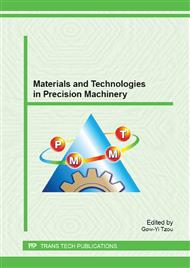[1]
J. S. Pellinen, M. Luukkala, Paper roughness measurement using airborne ultrasound, Sens. Actuators A 49 (1995) 37-40.
DOI: 10.1016/0924-4247(95)01011-4
Google Scholar
[2]
D. M. Jhonson, Model for predicting the reflection of ultrasonic pulses from a body of known shape, J. Acoustic Soc. of America, 59 6 (1976) 1319-1323.
DOI: 10.1121/1.381010
Google Scholar
[3]
D. Nicolett, B. Sorli, Measurement of changes in surface roughness using ultrasonic reflection, Quantitative Non-Destructive Evaluation, (1994) 1-8.
Google Scholar
[4]
G. P. P. Gunarathne, K. Christidis, Measurements of surface texture using ultrasound, IEEE Trans. Instrum. Meas., 50 5 (2002) 1144–1148.
DOI: 10.1109/19.963174
Google Scholar
[5]
D. D. Sukmana, I. Ihara, Application of air-coupled ultrasound to noncontact surface roughness evaluation, Jpn. J. Appl. Phys., 44 (2005) 4417–4420.
DOI: 10.1143/jjap.44.4417
Google Scholar
[6]
D. D. Sukmana, I. Ihara, Surface roughness characterization through the use of diffuse component of scattered air-coupled ultrasound, Jpn. J. Appl. Phys., 45 (2006) 4534–4540.
DOI: 10.1143/jjap.45.4534
Google Scholar
[7]
D. D. Sukmana, I. Ihara, Quantitative Characterization of Two Kinds of Surface Roughness Parameters from Air-Coupled Ultrasound Scattering, Proc. Symp. Ultrason. Electron., 27 (2006) 249-250.
Google Scholar
[8]
S. G. Roberts, G.A.D. Briggs, Characterization of surface roughness and subsurface damage, Final report on EPSRC, Oxford University, (1996).
Google Scholar
[9]
P. J. Hilton, Image surface roughness using correlated speckle grain pairs, Report No. DICTA/IVCNZ97, Massey University, New Zealand, (1997) 349–354.
Google Scholar
[10]
M. Bilgen, J.H. Rose, Focused ultrasonic probes and the effects of surface roughness on material noise, Review of Progress in Quantitative Nondestructive Evaluation, 13B (1993) 1769–1776.
DOI: 10.1007/978-1-4615-2848-7_227
Google Scholar
[11]
A. M. Abdelhay, I. M. I. Mubark, Ultrasonic evaluation of surface roughness using normal incidence pulse-echo technique, NDT. net, 9 4 (2004).
Google Scholar
[12]
F. Forouzbakhsh, J. R. Gatabi, I. R. Gatabi, A new measurement method for ultrasonic surface roughness measurements, Measurements, 42 5 (2009) 702–705.
DOI: 10.1016/j.measurement.2008.11.007
Google Scholar
[13]
F. G. Mitri, R. R. Kinnick, J. F. Greenleaf, M. Fatemi, Continuous-wave ultrasound reflectometry for surface roughness imaging applications, Ultrasonics, 49 1 (2009) 10-14.
DOI: 10.1016/j.ultras.2008.06.011
Google Scholar
[14]
Information on http: /www. nanovea. com/Application%20Notes/SandPaper. pdf.
Google Scholar


